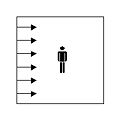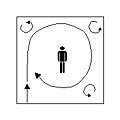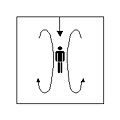Air duct
The terms air flow or type of ventilation are used in ventilation technology to describe the principle of the air flow path through the occupied area of the ventilated room. The air flow has a strong influence on the energy requirement (electrical, thermal or chemical energy) and comfort of a ventilation or air conditioning system .
Structure of the air duct systems
Air duct systems can be characterized according to three criteria:
- According to the degree of turbulence,
- according to the location of the air outlets (EN 12239),
- according to the shape of the relevant air flow at the air outlet (EN 12238) and
- according to the adjustability of the discharge direction.
The most common differentiation is based on the degree of turbulence. A distinction is made between two basic principles: low-turbulence displacement ventilation and turbulent dilution ventilation (mixed ventilation). The type and arrangement of the air outlets in the room are decisive for the design of the ventilation type.
The mixed flow is considered a compromise between inexpensive construction and the design requirements of the architects. This is why this type of ventilation is mainly used. EN 12238, which can be used to evaluate air outlets for use with mixed flow, differentiates between four classes according to the shape of the relevant air flow: Class I describes air outlets from which the air flow essentially emerges in three dimensions (nozzles and grille), Class II for air outlets from which the air flow exits radially along a surface or as a free jet (ceiling diffusers), class III for air outlets from which the air flow essentially emerges in two dimensions (linear grilles, slits and linear diffusers) and class IV for air outlets at low speeds.
The displacement flow is mainly used in areas where there are special requirements for the purity of the air or the hygiene of the room, e.g. B. laboratories , operating theaters , clean rooms . EN 12239, which can be used to evaluate low-speed air outlets for use with displacement flow, differentiates between three types according to location: Type 1 describes a horizontal air outlet i. d. Usually from walls, type 2 air outlets built into the floor for vertical air outlet and type 3 for air outlets built into the ceiling.
Displacement ventilation
Depending on the thermal situation, accumulation of pollutants, hygiene requirements and comfort requirements, two different types of displacement ventilation are available: piston ventilation and displacement ventilation . The aim of displacement ventilation is to use the "fresh" supply air ( outside air ) to push the existing room air with as little impulses and turbulence as possible with its pollutants as plugs from the ventilated area and to withdraw it from the room as exhaust air . For this purpose, the supply air is blown at low speed (0.2 m / s to 0.8 m / s).
Piston ventilation
In addition to the speed of the supply air, the perforation of the air outlets plays a decisive role in piston ventilation. The finer the perforation of the air outlet surfaces, the lower the degree of turbulence in the air. If the turbulence is very low, one speaks of laminar flow . With ideal laminar flow, the air jets run parallel to each other. Since the room air is displaced and the polluted and heated air is not reused as mixed air , changes in temperature and air quality can always be seen. Piston ventilation is a very effective type of ventilation, but it requires large free areas to guide air in the room.
Adjustability of the air outlets is particularly advantageous when the heat load changes regularly. With these outlets, the beam path of the supply air can be adapted to the temperature difference between supply and room air. This ensures that the area is always flowed through without an increased risk of drafts.
Displacement ventilation
With displacement ventilation, especially in rooms with a cooling load, fresh outside air is let in at low temperatures in the floor area. Only because of the heat sources (people, devices, etc.) does this fresh air rise upwards through buoyancy and always guarantee an optimal local air supply. The characteristic flow pattern includes the displacement layer above the ground and, depending on the location of the heat sources, a mixed layer above it.
During the design, it must be checked whether a vertical temperature profile is maintained that is justifiable from the point of view of thermal comfort. Depending on the level of activity of the user, the maximum permissible temperature rise between 0.1 and 1.1 meters room height is specified in DIN 1946-2 and DIN 1994-1. Displacement ventilation is not suitable for heating because warm supply air would escape directly upwards. The main advantages of displacement ventilation are that the displacement results in a good indoor air quality and low air velocities prevail in the occupied area.
Air flow with displacement flow
Dilution ventilation
Dilution ventilation is also known as mixing ventilation. By generating turbulent air currents, the room air is mixed with the supply air ( air induction ), which dilutes the pollutants contained in the room air. The air is not blown in over a large area, but punctually and at a higher blowing speed (impulsive) in order to achieve the necessary air induction. The blowing speed is usually 2 to 5 m / s, in very large rooms up to 15 m / s.
The additional air requirement to achieve equivalent ventilation efficiency and the required high pre-pressure of the air outlets go hand in hand with increased power consumption of the fans . The dilution ventilation ensures through the necessary high induction that the entire room is well mixed. The lack of a climatic or pollutant gradient is responsible for the fact that areas outside the occupied zone have to be ventilated, heated or cooled unnecessarily, e.g. B. Air area under the ceiling.
In rooms with a height of at least 4 m, an air outlet arrangement at a height of between 3.5 m and 5 m is recommended. If the ventilation and air conditioning system is operated both for heating and cooling, it is necessary that the air outlets are adjustable and not permanently set, as the air flows into the room differently in different applications. Depending on the temperature gradient between indoor and outdoor air, the air outlets must be able to adjust their outflow direction by means of a motor in order to ensure satisfactory mixed ventilation.
In a widespread variant of mixed ventilation, air outlets with built-in components are distributed under the entire ceiling area. The built-in components differ depending on the manufacturer and influence the air flow behavior in such a way that a separate mixing and flow area is created around each jet of supply air. In order to be able to adapt the air outlet to the current spatial and thermal conditions, the guide elements in the built-in components must be adjustable.
Air flow with dilution flow
Stratified ventilation
Stratified ventilation is well suited for industrial halls. The supply air is introduced into the occupied area with little impulse. If there are warm surfaces (e.g. machines) in this area, the supply air heats up and flows upwards due to the thermal lift. The pollutants emitted and the convective heat component of a work process are removed from the work area upwards. The thermal volume flow depends on the surface and room temperature as well as the size of the warm surface. As a free jet, the volume of the rising air increases as the jet path increases.
The air flow moved upwards by the thermal is replaced by the incoming air. A layer boundary is formed at the point where the supplied air flow and the air flow transported upwards are equal. The air enriched with pollutants is located in the upper hall area, which is extracted under the hall ceiling. The lower air layer in the living and working area almost reaches outside air quality.
literature
- Bernd M. Hanel: Indoor air flow . 2nd, revised edition. CF Müller, Heidelberg 1996, ISBN 3-7880-7557-0 .
Web links
Individual evidence
- ↑ EN 12238 . Ventilation of buildings - air outlets - aerodynamic testing and evaluation for mixed flow applications. Beuth, December 2001, p. 14 .
- ↑ EN 12239 . Ventilation of buildings - air outlets - aerodynamic testing and evaluation for use with displacement flow. Beuth, August 2001, p. 6 .
- ↑ Nicolas Fritsche: Pocket book for ventilation fitters and foremen . 8th edition. VDE Verlag, 2020, ISBN 978-3-8007-5072-6 , p. 66 .
- ↑ Nicolas Fritsche: Pocket book for ventilation fitters and foremen . 8th edition. VDE Verlag, 2020, ISBN 978-3-8007-5072-6 , p. 67 .
- ^ Hermann Recknagel, Eberhard Sprenger, Ernst-Rudolf Schramek (eds.): Pocket book for heating + air conditioning . 75th edition. Deutscher Industrieverlag, November 2010, p. 1050 ff .
- ^ Hermann Recknagel, Eberhard Sprenger, Ernst-Rudolf Schramek (eds.): Pocket book for heating + air conditioning . 75th edition. Deutscher Industrieverlag, November 2010, p. 1067 ff .
- ↑ Information on air outlets at Bosy-online.de; accessed in March 2015
- ^ Hermann Recknagel, Eberhard Sprenger, Ernst-Rudolf Schramek (eds.): Pocket book for heating + air conditioning . 75th edition. Deutscher Industrieverlag, November 2010, p. 1478 f .
- ^ Hermann Recknagel, Eberhard Sprenger, Ernst-Rudolf Schramek (eds.): Pocket book for heating + air conditioning . 75th edition. Deutscher Industrieverlag, November 2010, p. 1479 ff .







